
For a few years before the pandemic I was lucky enough to travel to Asia a few times—for work, for pleasure and as a translator of Chinese children’s books. Along the way, I developed a habit of doing quick surveys of the children’s books on sale in international airports, cities, and museums. These are not specialist children’s bookshops or foreign language bookshops, and I was simply looking to see what was on offer. I’ve written before about the low visibility of translated children’s books in the UK (where I live) and the Catch-22 situation this can create: low visibility means that books aren’t seen, or reviewed, or talked about, which means sales are low, which suggests there is limited demand, which discourages publishers and booksellers from taking on more translated books, and so on. I was interested to see the situation in countries where there are generally more translated children’s books available than in the UK. My impressions are from memory rather than factual data, and reflect my own interests and experiences as much as what was on offer at the time. They are, of course, from before the pandemic.
In terms of airports, my favourite bookshop was the WH Smiths at the Indira Gandhi International Airport in New Delhi. The children’s book section occupied about a quarter of the whole shop, had bookshelves at different heights, and offered a wide selection of books—mostly, but not exclusively in English; classics and contemporary stories, including strong Indian girl characters; and activity books. In retrospect, I wonder if it sticks in my memory because it was a surprise: perhaps it was the first time I’d noticed children’s books in Asian airports, or because there was so much on offer, or because they were titles I hadn’t come across before, and perhaps also because the shop felt so much lighter and brighter than the children’s book section I’d seen at Heathrow before the flight out, where somehow the books had seemed very dark: dark coloured covers, on dark low shelves, and rather dark stories. Overall, this children’s bookshop struck me as being very welcoming.
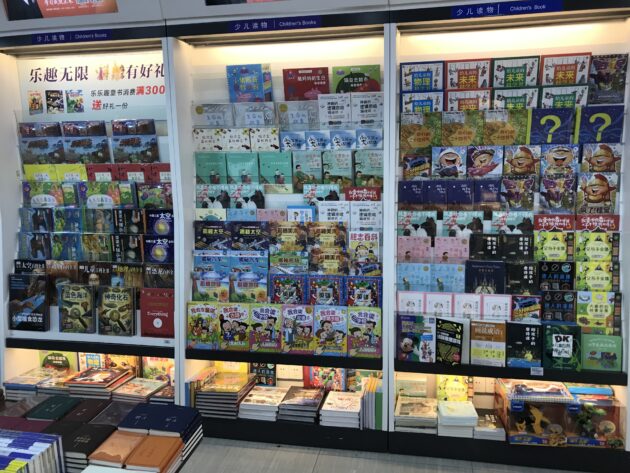
Bookshops in Chinese airports have changed in recent years. I’ve noticed more open shelving, which makes for a nicer browsing experience than repeatedly having to ask a sales assistant to unlock glass display cases. And there are more children’s books generally, which means there is often a more definable children’s section. These tend to offer a mixture of Chinese and translated titles. My impression is that many of these books are probably bought as gift items — considering that they are individually wrapped in plastic, often coded (e.g. blue or strong colours for boys, pink or light colours for girls) and sometimes extra-large or showy in some way. Although I have no data to validate this, I tend to associate UK or European airport bookshops with books that travellers intend to read themselves, and understand from Chinese friends that they mostly buy books for their children online. My impression is therefore of the children’s book section as a gift-section.
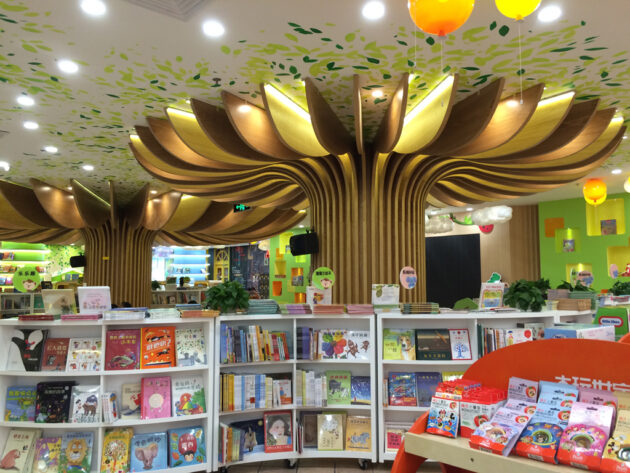
Bookshops in Chinese cities can be very large. In Shanghai’s Book City, the children’s section is up on the top floor, and is open and brightly lit (although windowless). There is a spacious central section for picture books, and regular shelving for middle grade books, very well stocked, often with half a dozen or more copies of each middle grade book. Conveniently for me, Book City stays open until ten at night, and no matter how late I have visited, there have always been adults and children browsing in the children’s section.
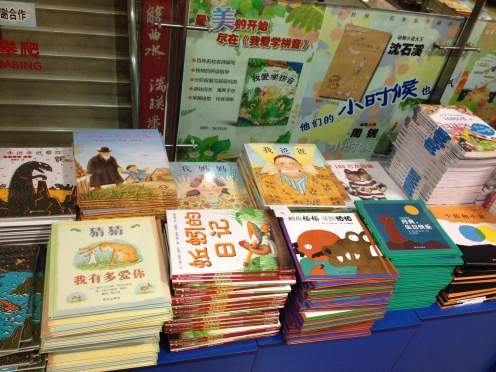
In the Xinhua Bookshop in Hangzhou, I was stunned to see tables stacked with translations of foreign picture books, and by stacks I mean ten or more copies of each title. Thinking back, I wonder if they might have been for a special event—perhaps for a specific group, in which each person might buy one copy of each book? In another section of the Hangzhou bookshop, was a floor to ceiling bookshelf filled with picture books, many translated from Japanese, Korean, English and other languages, and almost all individually wrapped. The floor to ceiling bookshelf was too high for me to reach the top shelves comfortably, and the lowest shelf was almost level with the floor. The sales assistants in the children’s book sections in the Shanghai and Hangzhou bookshops were very helpful, especially in middle grade books. As a translator, I made a point of looking for Chinese original content—books written by Chinese authors and illustrated by Chinese illustrators—and in Shanghai’s Book City, I noticed that the prime central space was given to translated picture books, with “homegrown” picture books relegated to the side. In the middle grade section of this bookshop, there was also a distinction between Chinese and foreign middle grade books, but it was less noticeable. My lasting impression from these two large bookstores was the focus on foreign picture books, the number of translated titles from Japanese and Korean (i.e. not just European languages), the quantity of books for sale, and the helpful sales assistants.
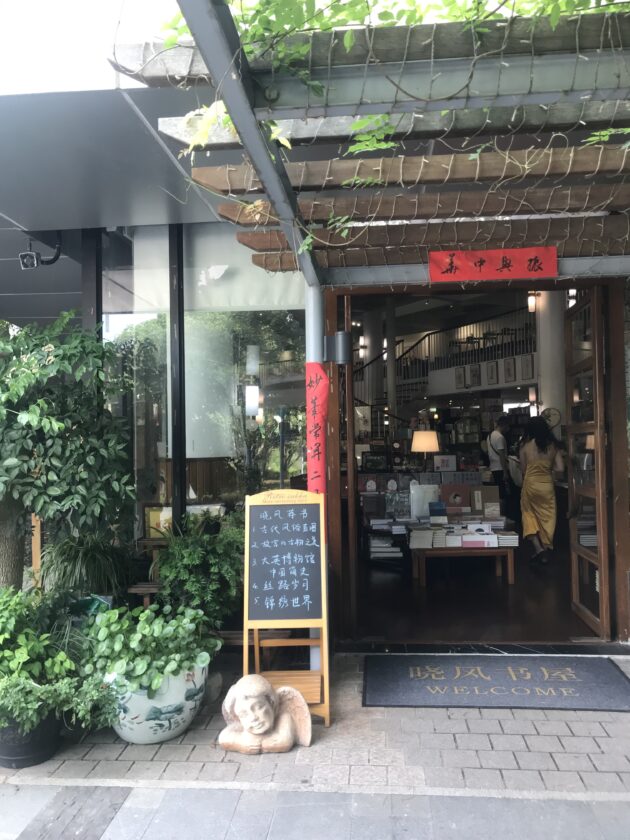
I’ve also looked at the children’s books available for sale in Chinese museums. My favourite museum for children’s books is the China National Silk Museum, in Hangzhou, which has a beautiful bookshop-cafe, including a small section dedicated to children’s books. It is a wonderful environment that encourages browsing: the buyers have a strong aesthetic sense and select beautiful books with quality content, both fiction and nonfiction, and display them with small, quality toys at a comfortable table height.
In the Shanghai Museum shop, I saw one or two books on an island display unit, but when I asked if there were more, the sales assistant pointed out a couple of shelves below, which I had missed. There were a few children’s titles there, a somewhat random selection of books, including some books about famous people in Chinese history, and some original and some translated titles. The Shanghai Museum has been actively developing programmes, activities and media for its younger visitors, and the year before I had ordered (from London) a copy of a children’s book produced by the Shanghai Museum, and was surprised not to see it displayed prominently.
At the National Museum of China, in Beijing, I found several shelves of children’s books at a comfortable eye-height, most of which were brightly coloured multi-volume series about exploring the world or exploring nature, but none that were specifically relevant to the collection or exhibitions there, nor did I find copies of children’s books that the NMC had co-produced (and that, again, I had previously ordered from London). Almost all the books were individually wrapped in plastic, probably with reason, because some that were not wrapped looked a bit grubby. When I asked the sales assistant if I could remove the wrapping on one book, she refused, and said it was a picture book and didn’t have many words in it. This is something I have heard before in China—that picture books are expensive and not value for money because there are hardly any words.
There was one bookshop that almost broke my credit card! This was A Closetful of Books, the pop-up bookshop at the Asian Festival of Children’s Content, in Singapore. This tiny space was packed with books from all over the world, restocked daily, and bustling with browsers for three days. There was an incredible range of books for all ages.
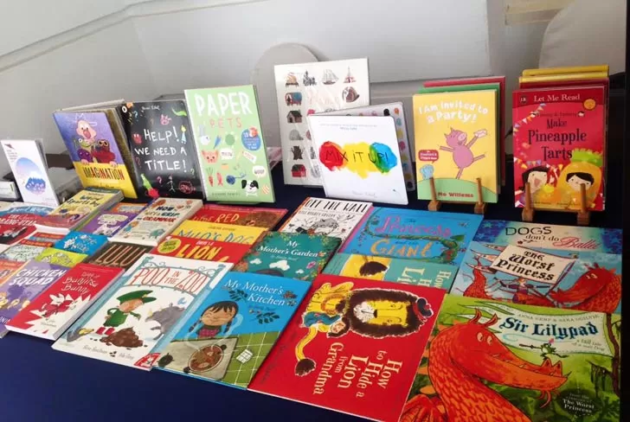
My mini-surveys of children’s books in airports, bookshops and museums are rough and ready, impressionistic and opportunistic. But in reality this is how many people browse for books. The people who buy books for children are often busy people—parents, grandparents, godparents, friends, colleagues, and teachers. Few of these people are experts in children’s books, or will have heard of national or international children’s book prizes. Considering how many children’s books are published, only a tiny number receive reviews in the mainstream press. When my own children were little, I wanted them to read books from around the world. I looked in bookshops and libraries (the internet was too young back then) and I didn’t know where else to look or to ask. I bought foreign language picture books on occasional visits to Europe, and asked friends and family to bring picture books from China. These days it’s much easier—there are wonderful blogs (WorldKidLit is a great starting place) and online bookstores. In a few months, a group of us at @WorldKidLit will start planning again for our annual #WorldKidLitMonth—every September—when we go all out to try and make children’s books around the world as visible as possible.

Helen Wang is an English sinologist and translator. She has worked as curator of East Asian Money at the British Museum in London since 1993. She has also published a number of literary translations from Chinese, including an award-winning translation of Dragonfly Eyes, by Cao Wenxuan.
This article was published in KJ102 (Encounters / Transitions), summer 2022.